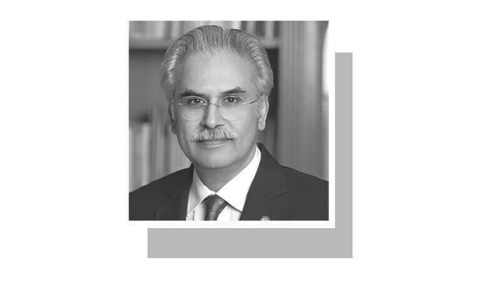VAZEER Agha was a scholar who had devoted himself to studying literature and he would sometimes derive wise principles based on his vast study in a larger context. Once, while critically evaluating humour and satire in our literature, he expressed his surprise over why despite a long and deep-seated tradition of Sufism in our culture, we are not able to rise above our own existence and behave in a sublime and noble way, as taught by Sufis all along.
Although he was commenting on some unsubtle, lampooning expressions — bordering on indecency — that abound in our classical literature, by extension the same may be applied to the expressions used by some members of our political elite. It seems that the ancient art of discourse is all but dead in Pakistani politics. And that, too, in presence of an overbearing religious narrative! Maybe, our politicians should read more literature and concentrate more on how to use language effectively rather than trying to recklessly blast every statement of their opponents. The art of rhetoric teaches us how to be precise, frugal and effective while speaking or writing.
The word rhetoric means ‘the art of effective or persuasive speaking or writing’, says Concise Oxford English Dictionary. But ‘the art was developed under particular political conditions, in democratic Athens and republican Rome. In these states the importance of speaking well in the public forum or the law courts was essential to political life and was deemed worth defending’ says Jennifer Richards in her book Rhetoric (Routledge, 2007). She says the resonance of the word rhetoric in our time is much different and it is now associated with ‘ostentatious or empty expressions’. We have a ‘dismissive conception of rhetoric with a political spin’, but in ancient Rome it was ‘impossible to imagine a society without rhetoric’ — in the real and original sense — she adds.
In literary context, the art of rhetoric has always been an integral part of Arabic, Persian and Urdu literature. Known as ‘ilm-e-bayan-o-badee’, it discusses and analyses the techniques and tools used in literature that include figurative language and figures of speech. Tropes and their classifications are considered very important in classical literature. Interestingly, rhetorical techniques were not only important in classical literature but even modern critical and linguistic theories, especially deconstructionism, take tropes and their meanings seriously.
In Urdu and Persian, a large number of books on ‘bayan-o-badee’ have been written. But a PhD dissertation by Muzzammil Husain comprehensively covers all the classes and types of tools and techniques used in our classical rhetoric. The thesis was published some time ago, but it flew off shelve as it fulfilled the needs of students, teachers and scholars alike. Now Lahore’s Fiction House has published it again. Titled Urdu Mein Ilm-e-Bayan-o-Badee Ke Mabahis and subtitled Tehqeeqi-o-Tanqeedi Jaiza, the 520-page work succinctly covers all the important aspects of exposition, tropes and their classes.
Having described in the first chapter what rhetoric is and what scholars of Persian and Arabic literatures have said on it, the book describes what are the semantic and lexical techniques used in it. Some of the techniques or tools used in literary rhetoric, especially in Persian and Urdu literatures, and covered by Dr Muzzammil in his second chapter include: tashbeeh (simile), iste’aara (metaphor), majaaz (trope), takraar (alliteration), mubalgha (hyperbole), idmaaj or ihaam (pun), tareekh goi (chronogram), tajahul-e-a’arifana (aporia), homonymy (tajnees), hashv (redundancy), kanaya (metonymy), majaz-e-mursal (synecdoche), manqoot (written with letters that have dots), ghair manqoot (written with letters that do not have dots), maqloob (anagram), vasil-ul-shiftain (letters denoting bilabial sounds), sayaqat-ul-a’adaad (text using digits) and many more.
Some beautiful and moving couplets by great poets have been quoted as illustrative examples to explain what a term really means. Proper references from authentic works have made it a valuable document for anyone interested in poetry, prosody, rhetoric, criticism and lexical issues.
The third chapter critically evaluates Urdu books that describe the art of rhetoric. The author says though rhetorical techniques were used in poetry since very beginning, the books explaining the techniques were written quite late and poets and even critics, especially writers of tazkiras, had assumed that readers were well-versed with all these terms and did not bother to explain the terminology. The earliest work in Urdu on rhetorical techniques is Bhed Bhaao. Written by Khoob Muhammad Chishti (1539-1614), it is a rare work and Moulvi Abdul Haq had introduced it.
Darya-e-Latafat (1807) penned jointly by Insha Allah Khan Insha and Mirza Qateel was the second book in Urdu on the art. Imam Bakhsh Sehbai (mercilessly killed by the British during 1857 war of freedom) had translated Hadaiq-ul-Balaghat, a famous Persian work by Shamsuddin Faqeer (1703-1769). The author has introduced over 50 other works.
Dr Muzzammil teaches Urdu and lives in Layyah, Punjab.
drraufparekh@yahoo.com
Published in Dawn, January 31st, 2022















































Dear visitor, the comments section is undergoing an overhaul and will return soon.